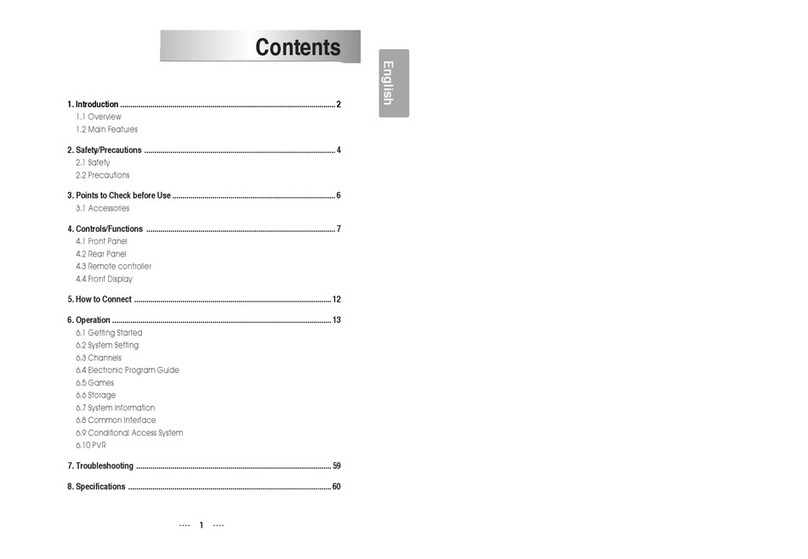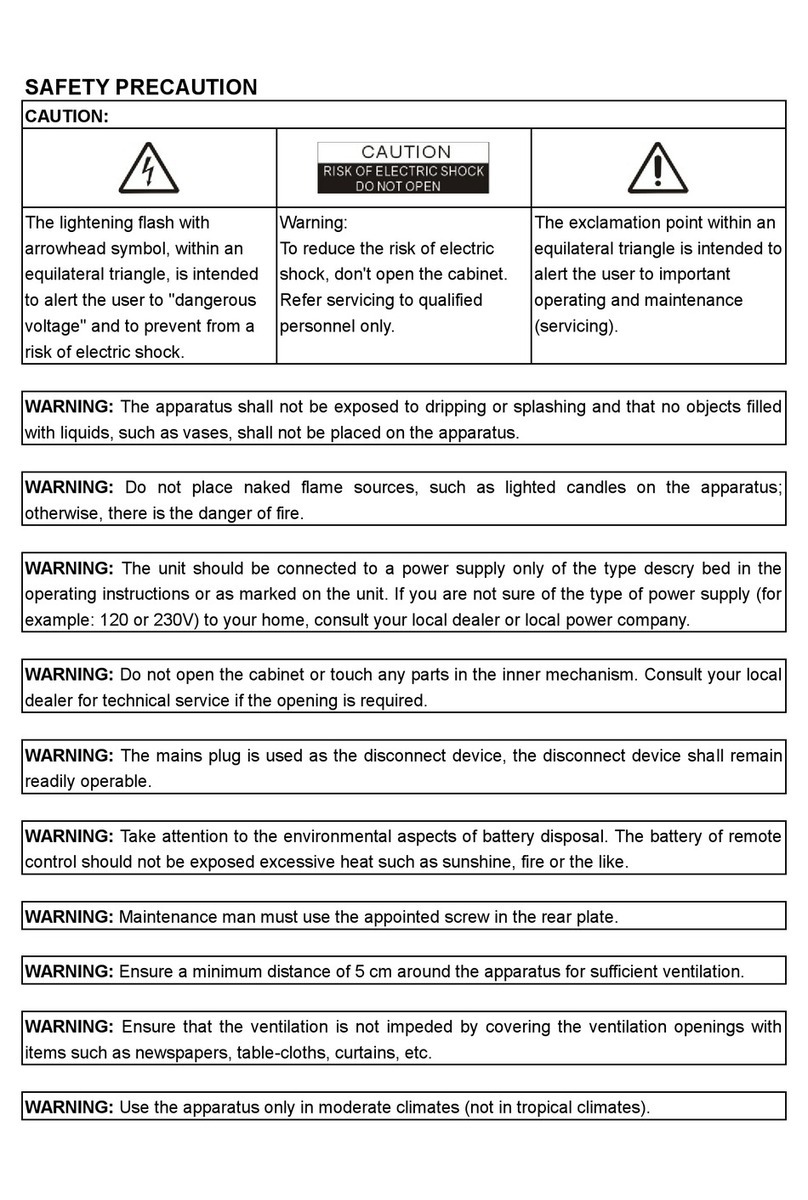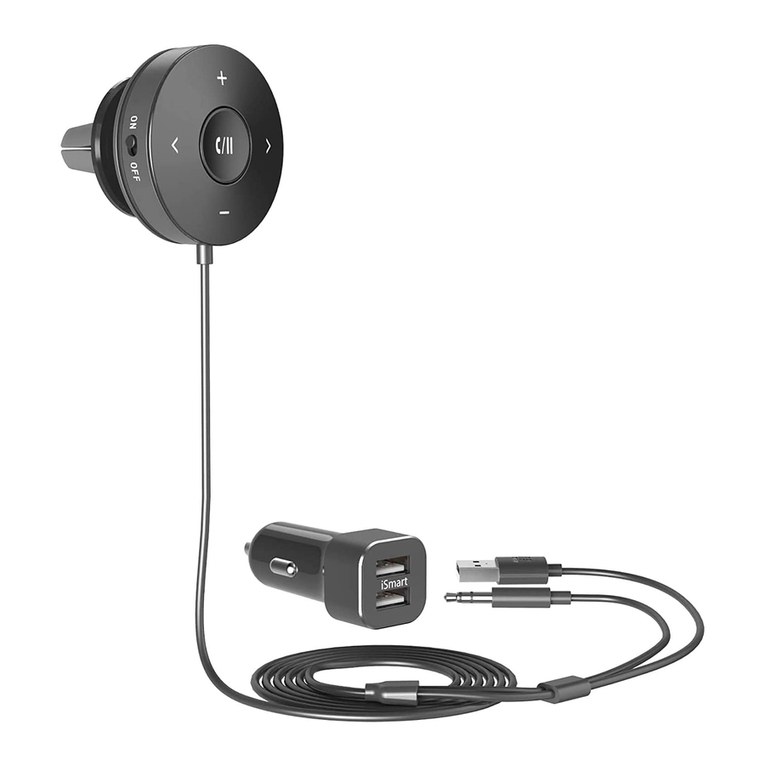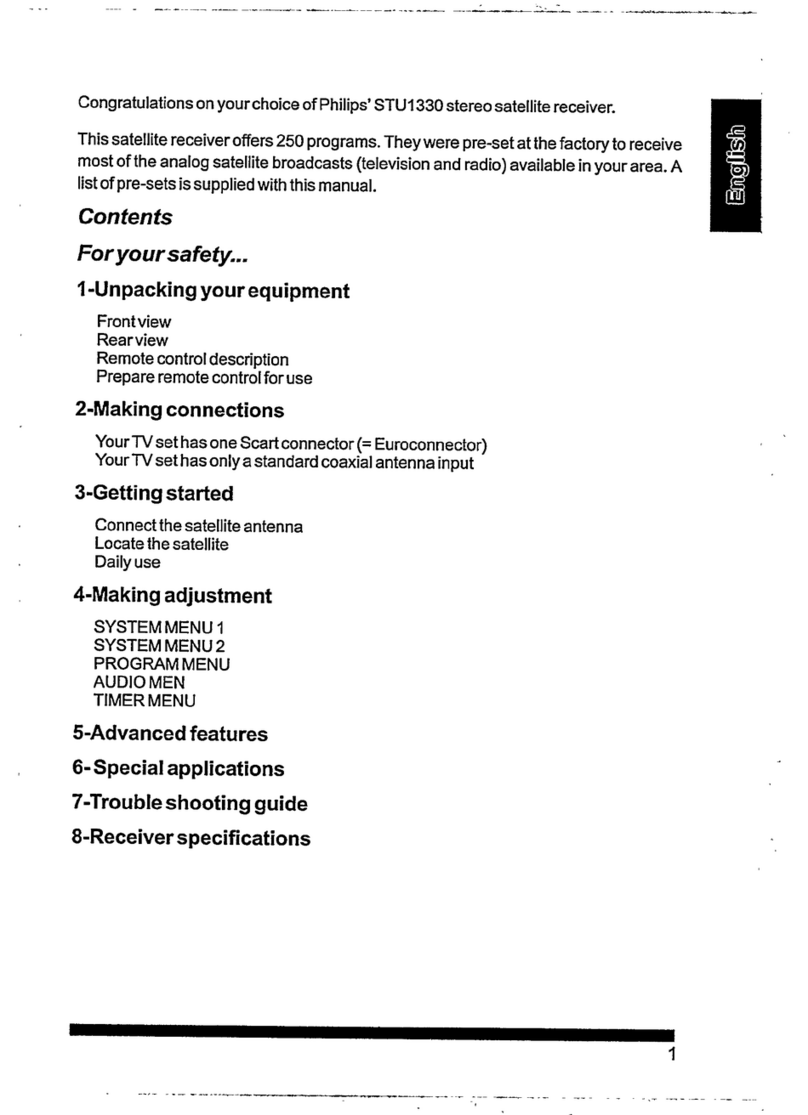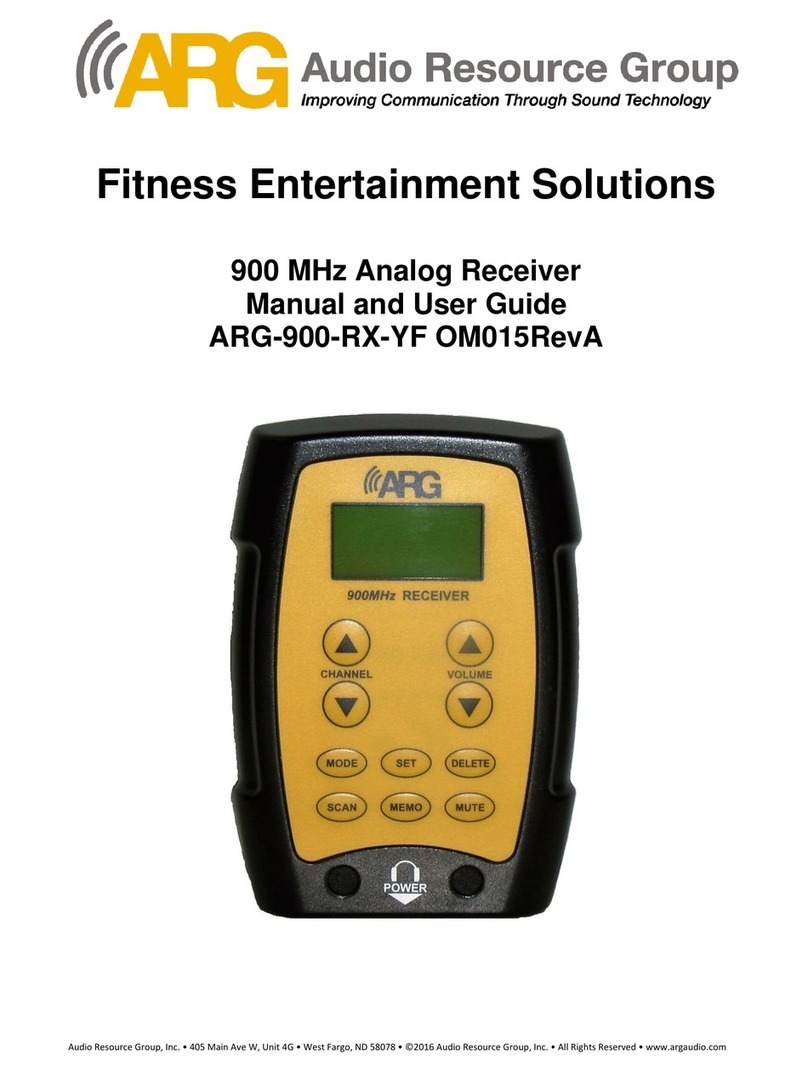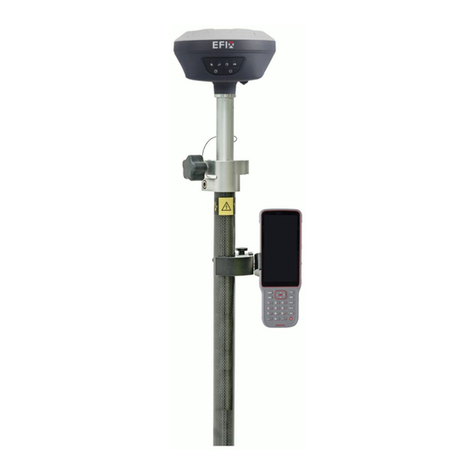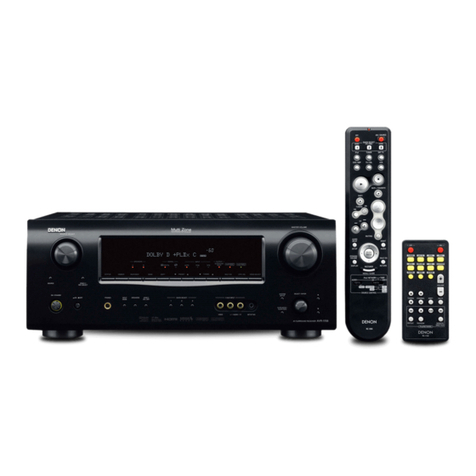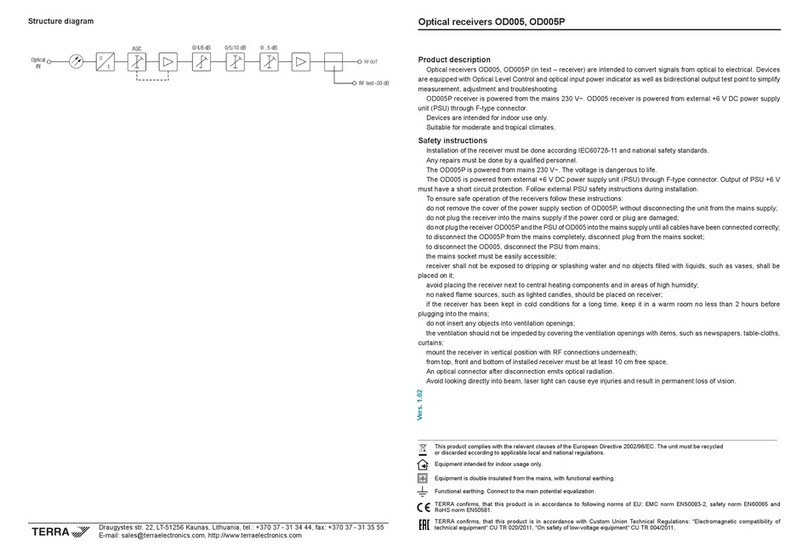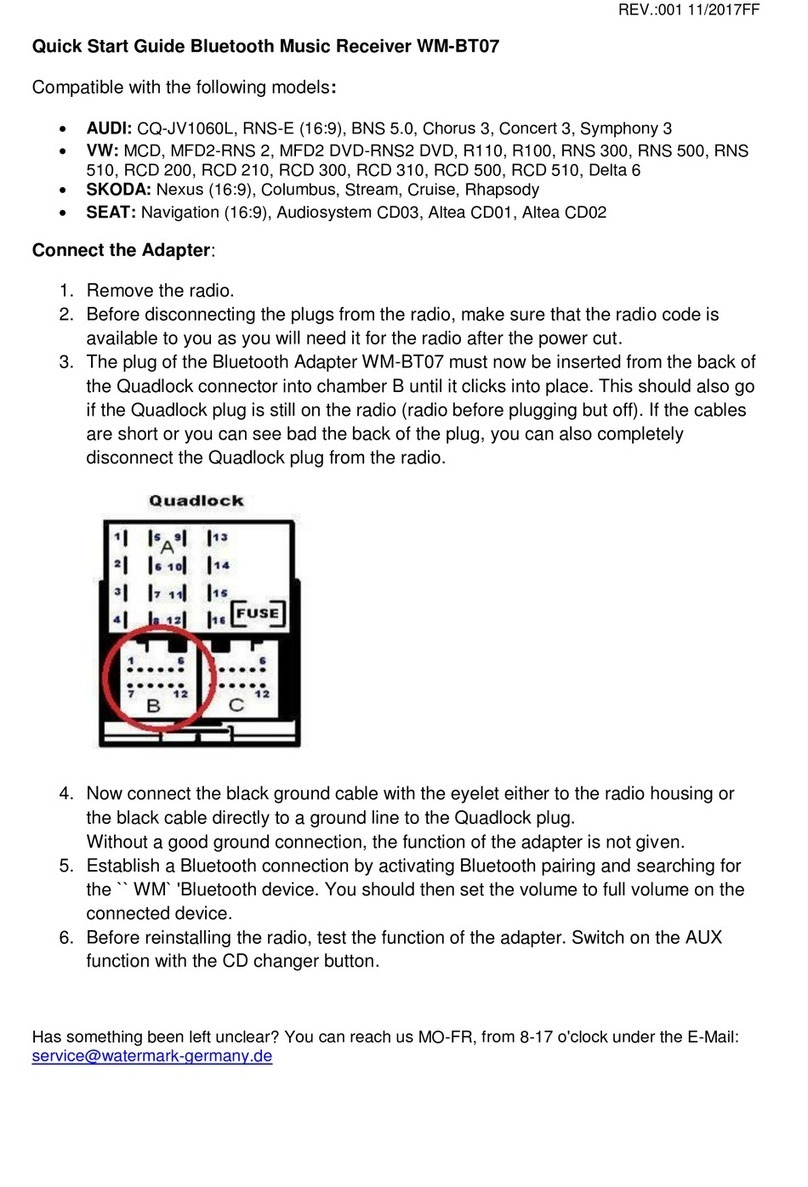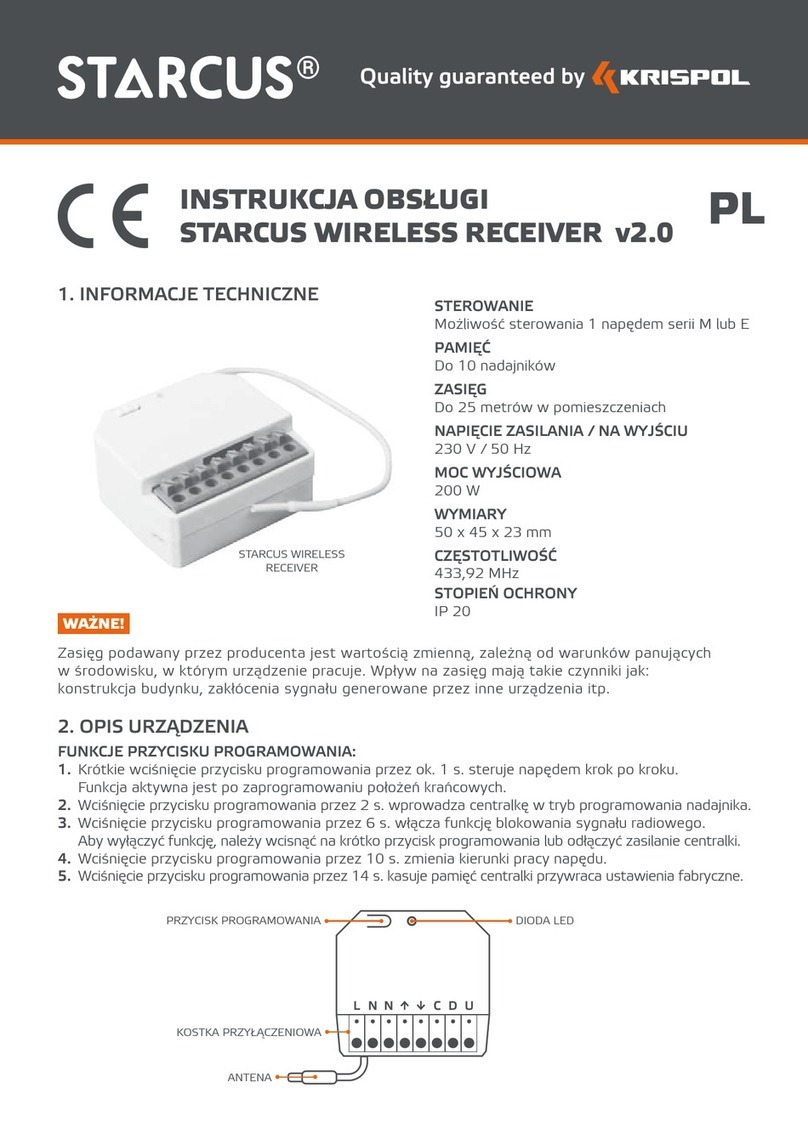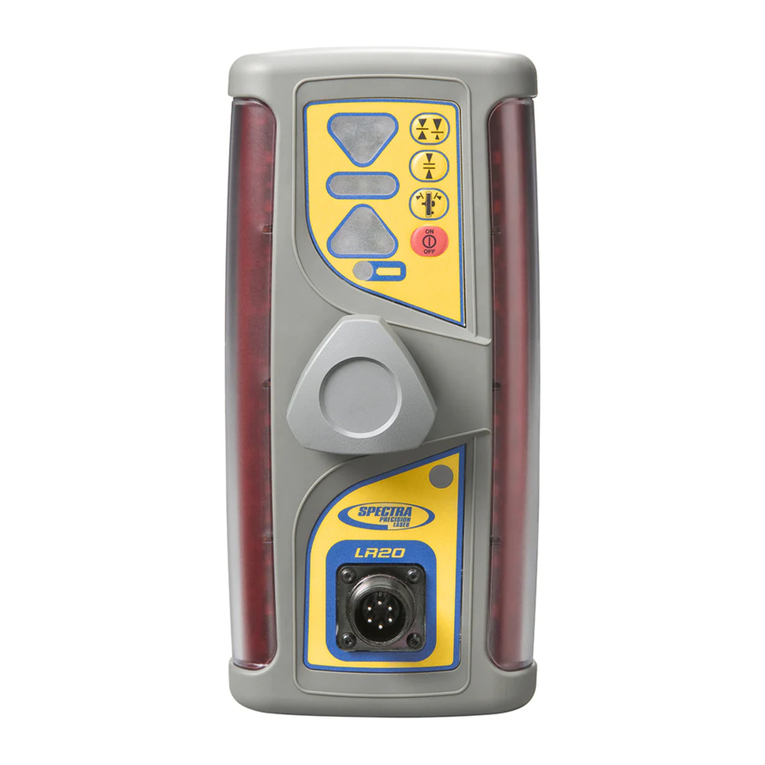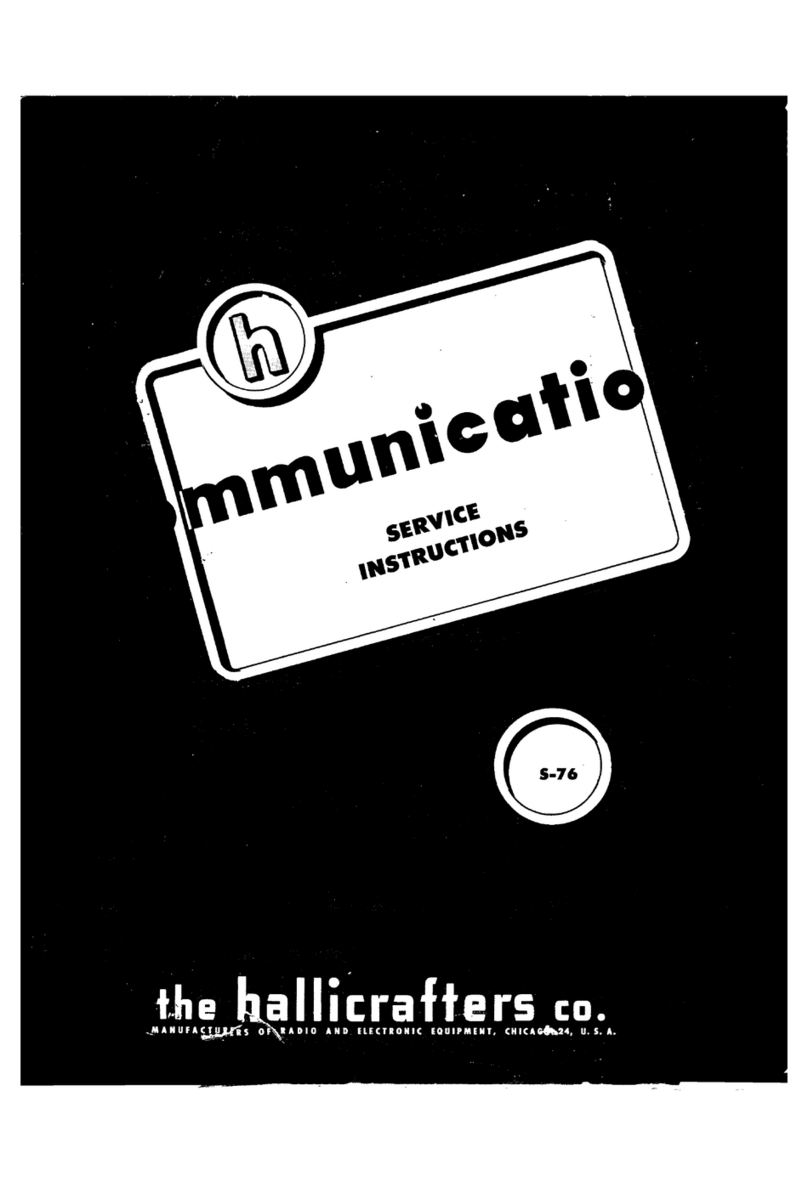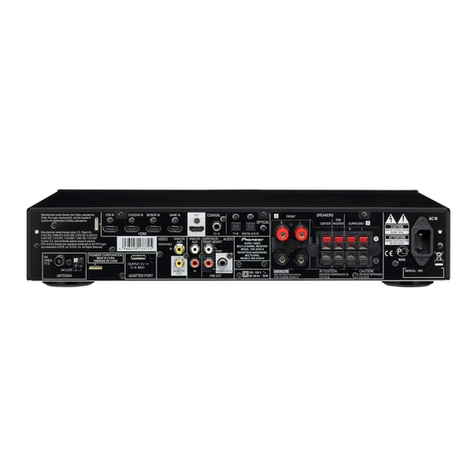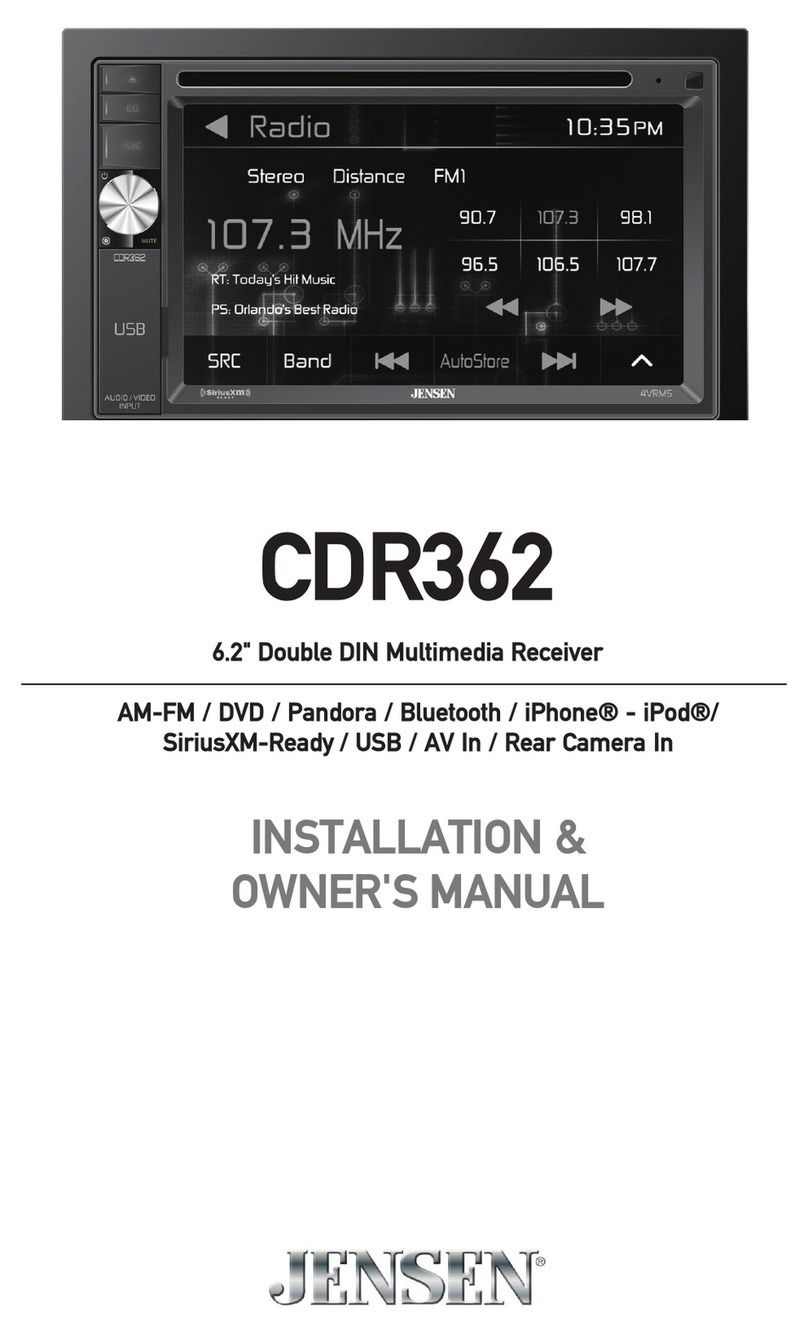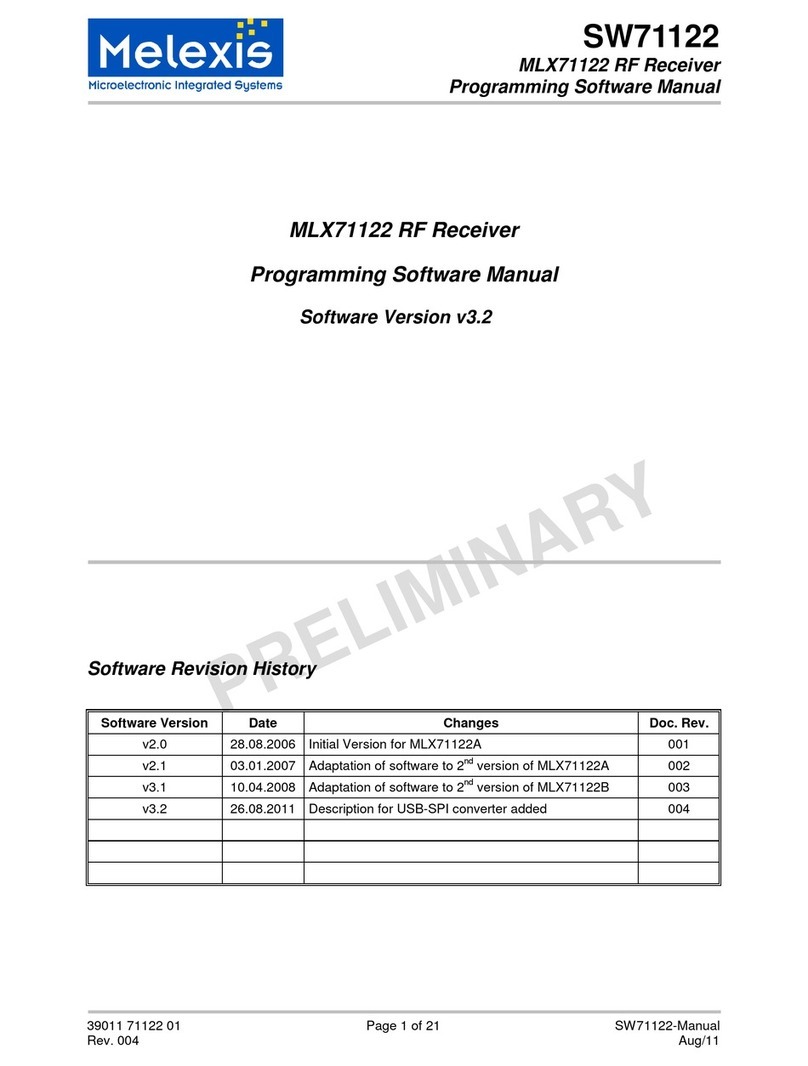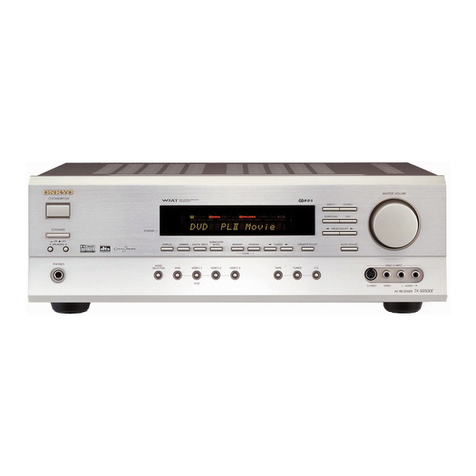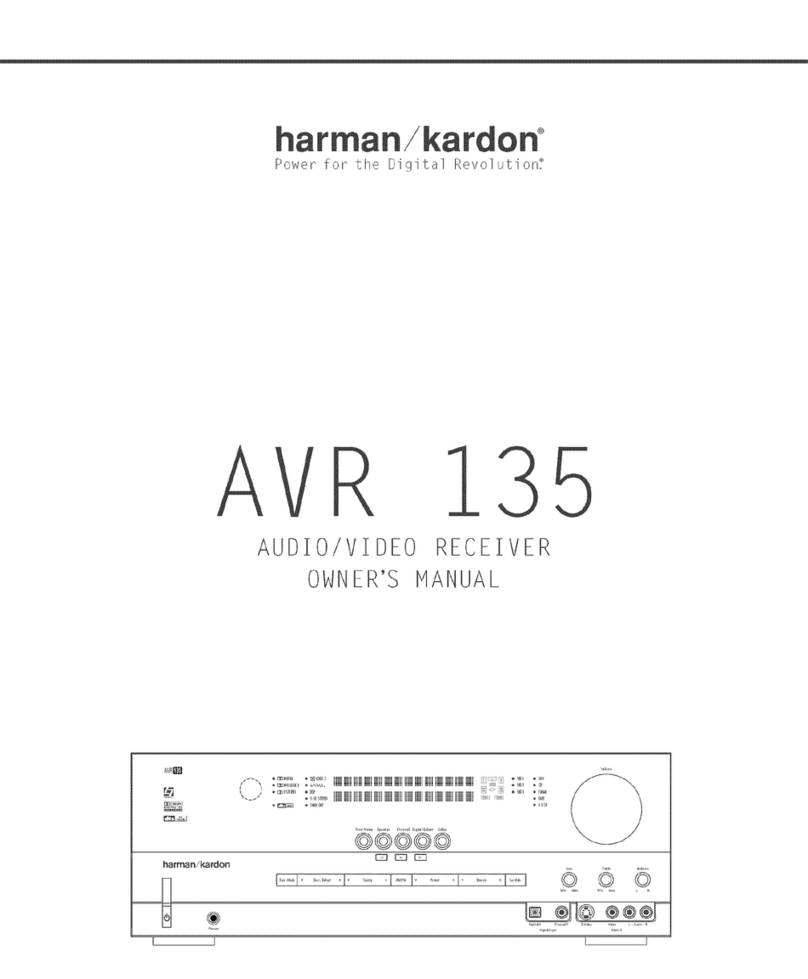Clarke-tech HD 5000C User manual

1
English
1. Introduction ........................................................................................................... 2
1.1 Overview
1.2 Main Features
2. Safety/Precautions ............................................................................................... 3
2.1 Safety
2.2 Precautions
3. Points to Check before Use ................................................................................. 5
3.1 Accessories
4. Controls/Functions .............................................................................................. 6
4.1 Front Panel
4.2 Rear Panel
4.3 Remote controller
4.4 Front Display
5. How to Connect .................................................................................................. 11
6. Operation ............................................................................................................. 12
6.1 Getting Started
6.2 System Setting
6.3 Channels
6.4 Electronic Program Guide
6.5 Games
6.6 Storage
6.7 System Information
6.8 Common Interface
6.9 Conditional Access System
6.10 PVR
7. Troubleshooting ................................................................................................. 58
8. Specifications ..................................................................................................... 59
Contents

2 3
English
This satellite receiver is designed for the reception of free-to-air and encrypted
channels. Depending on your location, enjoy the rich choice of up to 10,000 different
channels broadcasting a large range of programs: culture, sports, cinema, news,
events, etc. This receiver is assembled with highly qualified electronic parts.
Introduction
1.1 Overview
ᶀCompliant MPEG-II/ MPEG-IV/ H.264.
ᶀ2 tuner combo (DVB-Satellite & DVB-Terrestrial)
ᶀCompliant DVB-S/ S2 satellite standard & DVB-T standard
ᶀOutput resolution 576p & 576i, 720p, 1080i
ᶀ1 HDMI output
ᶀMultisatellite search.
ᶀOn-screen display with true color full resolution.
ᶀDiSEqC control version 1.0, 1.1, 1.2 and USALS compatible.
ᶀEnhanced 16 favorite channel groups.
ᶀPowerful channel control by favorites, lock, skip, move and delete function.
ᶀChannel sort by alphabet, transponder and CAS.
ᶀMultilingual GUI (OSG & Menu): English, Spanish, Portuguese, French, German, Italian,
Turkish, Arabic, Persian, Russian, Greek, Czech, Romanian.
ᶀInstallation wizard
ᶀExtended EPG and program reservation on EPG.
ᶀTeletext & Subtitle by OSD and VBI
ᶀLast channel memory function.
ᶀTotal 10,000 channels programmable.
ᶀPreprogrammed channels (Optional)
ᶀDolby digital audio output (S/PDIF)
ᶀS-Video
ᶀComponent output (YPbPr)
ᶀVarious games
ᶀSoftware & channel database upgrade via RS-232C: PC to STB/ STB to PC.
ᶀParental lock / Installation lock / receiver lock.
ᶀZoom in function on pause/ live channel
ᶀMultipicture display.
ᶀVideo color adjustment function.
ᶀHigh speed software upgrade via USB 2.0
ᶀMP3 play and JPEG viewer
ᶀSupport 2 USB Port on Front Panel & Rear Panel
ᶀeSATA (External SATA Interface, 7200RPM support only)
ᶀLan 10/100Mbps Ethernet
ᶀManufactured under license from Dolby Laboratories.
“Dolby” and the double-D Symbol are trademarks of Dolby Laboratories.
1.2 Main Features
Be sure to read this user's manual before
starting the operation of the unit.
Do not touch the power cord with wet
hands as it may cause electric shock.
Never open the cover. It is very
dangerous to touch the inside of the
unit due to possible electric shock.
Place the unit in a well ventilated and
no-heat environment.
When you do not use this unit for a
long time, make sure that power cord
is pulled out from the outlet. Also do
not use a damaged power cord as it
may cause fire or electric shock.
A professional installation is required.
If reception is interrupted, contact
your local service centre.
Safety/Precautions
2.1 Safety
DiSEqC is a trademark of EUTELSAT

4 5
English
When installing the unit
2.2 Precautions
Install the unit horizontally. An uneven
installation may cause the unit to be
damaged.
Do not put heavy items such as a TV
set on the unit. That may damage
the unit.
Do not leave the unit where the
water drops or splashes.
Do not put water holding items such
as vases on the unit.
Do not install the unit:
⍥Where it is subject to vibrations
⍥Where it is exposed to direct sunlight
⍥Where there is humidity
⍥Where the temperature is too high or too low.
⍥Where there is no ventilation
Moving the unit to a hot area from a
cold one will cause condensation.
Do not operate the unit for one or two
hours or until it has dried completely.
User's manual : 1
User's manual
Remote control : 1
Batteries (AAA type) : 2 HDMI cable : 1
ᶀIf any of the above-listed
accessories is missing, contact
your sales representative.
The accessories below are included with this receiver:
Points to Check before Use
3.1 Accessories
Your dish should be properly installed and azimuth and elevation must be precisely set up.
ᶀThis unit supports DiSEqC 1.2 and can work with a compatible antenna positioner.
Ask your dealer for information.
ᶀThe mains plug is used as the disconnect device.
The disconnect device shall remain readily operable.
3.2 The Satellite dish

6 7
English
Controls/Functions
4.1 Front Panel
4.2 Rear Panel
Standby/Power on Indications Lamp : Flashes red light in “Standby” mode and
shows no light in “Power ON” mode.
Power : Switches the receiver between “Standby” and “Power ON” modes.
Menu : To enter or exit the main menu.
Select : To show the Channel List in non-menu mode and select on item or
confirm in menu mode.
- VOL
ȜȞ : To change the volume level in non-menu mode and modify
a setting in menu mode.
- CH ƌƊ : To switch channels or change the cursor position on the
application screen.
87
65
4
3
2
1
No. Name Connector Function
1ANT IN IEC 169-2 FEMALE Input from terrestrial antenna
2ANT OUT IEC 169-2 MALE Loop-through output from digital tuner
and Output to TV
3LNB INPUT IEC 169-24 FEMALE IF input from LNB to digital tuner
4LNB OUTPUT IEC 169-24 FEMALE IF loop-through output from digital tuner
5USB USB A-type USB 2.0
6VCR/AUX SCART SCART CVBS Video Output
CVBS, RGB Video Input
Audio Output
7TV SCART SCART CVBS Video Output, Audio Output
8eSATA E-SATA External SATA
9HDMI HDMI Digital Video/Audio Output
10 RS-232C DB-9 Low speed serial port
11 LAN RJ-45 10/100Mbps Ethernet
12 S/PDIF Fiber Optic Digital audio output (Optical)
13 VIDEO RCA cinch Composite video output
14 AUDIO L RCA cinch Left audio output
15 AUDIO R RCA cinch Right audio output
16 Y RCA cinch Component video output(Y)
17 Pb RCA cinch Component video output(Pb)
18 Pr RCA cinch Component video output(Pr)
19 S-VIDEO MINI-DIN S-VHS Output
2
1 3 6
10 1314 16 17
1 3 4 5 6 7 8
2 4 5 87 9
11 12 15 18 19

8 9
English
4.3 Remote controller 4.3 Remote controller
POWER :To turn the receiver On/Off.
TV/RADIO : To switch between TV and
Radio.
MUTE : To turn the sound On/Off.
TEXT : To show the teletext contents if
teletext is transmitted. Used for special
functions in menu mode.
SUBTITLE : To show the subtitle contents if
subtitle is transmitted.
AUDIO : To show the Multi-language audio
track, the stereo-mono mode and subtitle
information. Used for special functions in
menu mode.
MOSAIC : To display multiple pictures.
SLEEP : To set the STB off after minutes.
FREEZE : To pause the video. Press again
to resume the video.
ZOOM : To zoom In/Out.
GUIDE : To show the TV/Radio program
guide.
INFO : To show information about the
current program. Press twice to show
detail.
RECALL :To move to the previous
channel. Used for special functions in
menu mode.
GROUP :To change the channel
groups(Satellites or favorite groups).
MENU : To enter or exit the main menu.
EXIT :To exit from the present menu and
move to the previous menu.
-Vol Up & Down : To change the
volume level in non-menu mode.
1817
16
15
14
13
12
11
10
9
8
7
6
5
4
3
2
1
-Double arrow Up/Down : To move to
the next or previous page when
many pages are available.
-Up & Down : To switch channels in
non-menu mode and move the
cursor up/down in menu mode.
-Left & Right : To change the volume
level in non-menu mode and modify a
setting in menu mode.
OK : To show the Channel List in non-menu
mode and select an item or confirm in
menu mode.
FILELIST :To display the filelist.
PLAY :Play Content.
STOP :Stop Playback.
RWD : Playback in rewind mode.
PAUSE : Pause playback.
FWD : Playback in forward mode.
ADVANCE : Go to live channel.
REC : Start recording.
SLOW : Playback in slow mode.
-Color Key : Select the option such as
View List, Select Disk, Rename.
Numeric Keys (0-9) : To enter numerical
settings (such as channel numbers)
directly.
V.FORMAT : To switch the resolution of
video output.
Wide : To select a TV aspect ratio with Pan
Scan or Letter-Box(4:3) (Full screen or Pillar
box(16:9).
41
40
39
3835
34
33
32
31
30
29
28
27
26
25
2423
2221
2019
1
4 6
7
10
11 14
15
17
18
16
3
23
21
22
19
24
20
26
27
29
28
31
38
35
41
40
39
34
9
13
12
25
33
37
2
5
8
30
32
36

1Indicates Power (On/Off) mode
2Lights when the signal comes in via satellite dish
3Lights when the current channel is recording
4Lights when Time-Shift Mode is set to enable
5Lights when Time-Shift Mode is set to enable
6Lights when a timer setting in standby mode
7Lights when the signal is HD
8Lights when USB devices is connected
9Indicates the current channel is set to Lock mode
10 Lights when the current chanel is Dolby audio format
11 Lights when the current sound is set to Off
12 Feature not supported
13 Feature not supported
14 Ligths when Mp3 player is enabled
15 Lights when loop mode is setting in Mp3 player
16 Lights when the current channel is Radio mode
17 Lights when the current channel is TV mode
18 Lights when the signal comes in via TV Antenna
19 Indicates when the current playback mode in file list
20 Lights when Media & Recorded file is playing and revolving on
the outer circle
21 Indicates the resolution of video ouput
22 Indicates the Progressive or interlaced scanning mode
11
English
How to Connect
When Connecting the Receiver to a TV with RF connectors
4.4 Front Display
Connect the TV antenna to TV ANT IN
Connect the Video and Audio of the TV to Video and Audio: connect the red
and white connectors to Audio R and Audio L, and the yellow connector to
Video
Connect your satellite dish
3
2
1
10
1 2 3 4 5 6 7 8 9
10 11 12 13 14 15
1716 19 20 212218

13
English
12
6.1 Getting Started
⊼Select the item that you want to edit, and set its parameters as desired. <Dish Setting>
- LNB Power : Select among ON/OFF/13V/18V.
- LNB Type : Select among Single/Universal/OCS.
- LNB Freq : Set the frequency of the LNB oscillator.
- 22KHz : When not AUTO, set the signal path from LNB or switch by selecting a control
signal among 0/22KHz.
- DiSEqC switch : Select DiSEqC protocol among OFF/1.0/1.1 as appropriate for your
configuration.
- Committed/Uncommitted : Select the DiSEqC port.
⊽Select the item that you want to edit and set its parameters as desired. <Motorized
Setting>
- Frequency : If the default TP frequency is not appropriate, you can select another TP
frequency at which to check for signal.
- DiSEqC Motor : Select DiSEqC protocol among OFF/1.2/USALS as appropriate for your
Motor.
<Figure 6.1.3> <Figure 6.1.4>
3) Antenna Setup
⊹Press the MENU button to display the main menu.
⊺Use / and / to move in the menu.
⊻Press on ‘Dish Setting’. The following window will appear. <Figure 6.1.3>
If you have a motorized dish, press on ‘Motorized Setting’. < Figure 6.1.4>
ҫ
Note : Enter a 4-Digit password if need arise. The default password is ‘0000’.
VOL
VOL
CH
CH
Operation
6.1 Getting Started
After your receiver is powered on, proceed with installation as follows :
1) Menu Language Setting
⊹Turn on your TV and receiver.
⊺The pop-up menu for language selection will appear.<Figure 6.1.1>
Select one language and press to proceed.
<Figure 6.1.1>
2) Country Setting
⊹Select a country and press the button on.
<Figure 6.1.2>

15
English
14
6.1 Getting Started
4) Satellite Scan
Through this function, the receiver searches for all the available channels and saves them
in memory.
ᶀAuto Scan <Figure 6.1.5>
⊹To select more than one satellite, press the RED button when the selection bar is
positioned on the satellite.
⊺Press on the names of the satellites that you want to scan under 'Satellite List'.
Press the EXIT button to close the 'Satellite List'.
⊻Press / and set the ‘Search Type’ and ‘Network Search’ parameters.
- Search Type : Decide for which channels to search (All channels/ Free channels
only/ TV channels only).
- Network Search : Set ON to find more transponders (frequencies) through a Network
Information Table (NIT) scan. That is, when the broadcaster is
sending a NIT through a given transponder, the receiver will also
scan for transponders listed in the NIT and not otherwise
recognized. (this can happen when a transponder is new)
⊼Press under ‘SCAN’ to scan the selected satellites. <Figure 6.1.6>
CH
CH
<Figure 6.1.5> <Figure 6.1.6>
6.1 Getting Started
(When the DiSEqC Motor parameter is set as 1.2)
- Move : You can move the dish to the West/East.
- Limit : If you want to set limits, press .
- Disable Limit : You can disable the East and West limits.
- Goto Center : Move the dish to the initial 0 position.
- Set East / West Limit : Move the dish East or West using / .
Press to set East or West limit.
(When the DiSEqC Motor parameter is set as USALS)
- Sat Degree : Satellite location.
- Antenna Position : Press .
- Goto Reference : Move the dish to the reference 0 position.
- Antenna Longitude : Your longitude at present.
- Antenna Latitude : Your latitude at present.
ҫ
Note : You need to know what LNB you are using to correctly set the L.O. (local
oscillator) frequency.
ҫ
Note : You need to understand how your receiver is connected to properly set the
22KHz and DiSEqC.
⊾When you are done, press the EXIT button.
VOL
VOL

17
English
6.1 Getting Started6.1 Getting Started
ᶀBlind Scan <Figure 6.1.7>
⊹Select the satellites you want to search by pressing the button on the remote.
⊺Press / to set the “Polarization” and “Scan Mode” options. - Polarization :
Select Vertical / Horizontal / All.
- Scan Mode : Select Fast / Detail.
⊻SCAN : Begin channel search of the selected satellites.
ᶀManual Scan <Figure 6.1.8>
⊹Select a transponder.
⊺To change a transponder’s information (Frequency, Symbol Rate), use the NUMERIC
buttons.
⊻To add a new transponder, press the GREEN button.
⊼To delete a transponder, press the YELLOW button with the cursor next to the
Frequency parameter.
⊽To search a transponder, set its different parameters and press .
CH
CH
ᶀPackage Identifier (PID) Scan <Figure 6.1.9>
⊹Select a transponder.
⊺To change a transponder’s information (Frequency, Symbol Rate), use the
NUMERIC buttons.
⊻To add a new transponder, press the GREEN button.
⊼To delete a transponder, press the YELLOW button with the cursor next to the
Frequency parameter.
⊽To search a transponder, set its different parameters and press / . You can
search a specific channel of the transponder by setting its PID data (Video, Audio
and PCR).
CH
CH
ҫ
Note : If you cannot access programs after correctly completing a scan procedure,
please contact your seller or your installer.
<Figure 6.1.9>
<Figure 6.1.7> <Figure 6.1.8>
16

19
English
6.1 Getting Started
5) Terrestrial Scan
Through this function, the receiver searches for all the available channels and saves them
in memory.
ᶀAuto Scan <Figure 6.1.12>
⊹Press the YELLOW button when the selection bar is positioned on any item and
“Scanning menu” will appear on the screen. <Figure 6.1.13>
ᶀManual Scan <Figure 6.1.14>
⊹Select the channel number or frequency you want to search for select the channel
number by pressing CH ƌor CH Ɗon the remote control, or specify a frequency by
entering the frequency with the number keys. <Figure 6.1.15>
⊺For the Bandwidth choose either 7 MHz or 8 MHz.
⊻For the Search Type, select All Channel, FTA Only or TV Only.
⊼For Network Search, select ON to find the most channels available.
The strength and quality of the signal from the selected channel is shown by the
Level and Quality indicators near the bottom of the screen.
⊽Press to begin the scan.
<Figure 6.1.12> <Figure 6.1.13>
<Figure 6.1.14> <Figure 6.1.15>
18
6.1 Getting Started
ᶀFast Scan <Figure 6.1.10>
⊹For Provider choose either Canal Digitaal or TV Vlaanderen.
⊺For CHs Renumber select ON/OFF
⊻Press the Red button.
<Figure 6.1.10> <Figure 6.1.11>

21
English
20
6.1 Getting Started
7) Other Functions of the Remote Control
ᶀVolume Control
⊹While watching a program, press or to control the volume.
⊺You can press the MUTE button to remove the sound of the program: the mute icon
will be displayed. Press the MUTE button again to turn the sound back on.
ᶀChannel Information
⊹You can press the INFO button to display the information banner for a few seconds.
⊺If you then press the INFO button again, a detailed banner will be displayed.
ᶀTV/ RADIO switching
You can press this key to change from a TV channel to a Radio channel or vice versa.
ᶀRECALL
Press to return to the previous channel.
ᶀAudio
Press to adjust the subtitle and/or audio status of the current channel:
- Audio Mode : Select between, Stereo ᵎMono-Left ᵎMono-Right
- Audio Track : Select between tracks available in this program
- Audio Level : Select between, High ᵎMedium ᵎLow
ҫ
Note : These subtitle and audio parameters are workable only when the desired
channel supports these functions.
ᶀTEXT
The Teletext service is a text data service sometimes available from the Service
Provider.
ᶀFREEZE
You can press this key to freeze the video. Press it again to resume the video.
ᶀGROUP
When watching TV or listening to Radio, you can press this button to view the list of
satellites and/or favorite channel groups.
Only registered satellites and favorite groups are displayed.
VOL
VOL
6.1 Getting Started
6) Channel Selection
You can use / to navigate between channels until you find the channel you
want.
ᶀIf you know the channel number, you can enter it with the NUMERIC buttons and wait
2 seconds until the channel is changed.
ᶀIf you know the channel name or transponder or CAS, you can press to display the
channel list <Figure 6.1.16>
CH
CH
<Figure 6.1.16>
⊹In the left side of screen, detailed information about the selected channel will be
displayed. (Satellite Name, Frequency(Polar) and Channel Name)
⊺You can use the following buttons to navigate between channels:
- / :Moves one channel up/ down.
-/ :Moves one page up / one page down.
- RED : Shows all channels in the current group.
- GREEN : Shows all channels sorted alphabetically.
- YELLOW : Shows all channels sorted by Transponder.
- BLUE : Shows all channels sorted by CAS system.
⊻Press when the selection bar is positioned on the desired channel.
VOL
VOL
CH
CH

23
English
22
ᶀSUBTITLE <Figure 6.1.20>
You can press to select the subtitle language of current channel.
ᶀSLEEP <Figure 6.1.21>
You can set the your receiver to turn off after a few minutes. Press to set the sleep
timer.
- To cancel the sleep timer, please press until you set time as “0 min”.
(Disable, 10, 20, 30, 60, 100, 120 Minutes)
ᶀV.FORMAT <Figure 6.1.22>
You can press to change the video resoultion Select between, 1080i ᵎ720p ᵎ
576p ᵎ576i.
ᶀWIDE <Figure 6.1.23>
You can press to change the TV aspect ratio.
- 4:3 : Pan-Scan or Letter-Box
-16:9 : Full-Screen or Pillar-Box
6.1 Getting Started
<Figure 6.1.20> <Figure 6.1.21>
<Figure 6.1.22> <Figure 6.1.23>
6.1 Getting Started
ᶀMulti Picture Display <Figure 6.1.17>
You can press to display multiple pictures; you can choose the number of pictures
such as 1X2, 2X2, 2X3 or 3X3.
ᶀZOOM
You can press to zoom in the video. <Figure 6.1.18>
⊹Press the PAUSE button and press . You can zoom in sections of Freezed Video
<Figure 6.1.19>
⊺While watching a program, press . You can zoom in sections of playing video.
⊻To cancel the freeze status, please release the zoom status.
<Figure 6.1.17>
<Figure 6.1.18> <Figure 6.1.19>

25
English
24
2) A/V Output Settings
This submenu allows you to specify the audio/video output. <Figure 6.2.2>
- Audio Language : Set the default audio language when selecting a channel.
- Subtitle Language : Set the default subtitle language.
- SCART : Select the SCART output.(CVBS/RGB)
- Screen Format : Select the screen format. (16:9 / 4:3)
- Display Format : Select the TV aspect ratio(Letter Box/Pan Scan, Full Screen/Pillar Box)
- Video Format : Select the Scanning type(Interaced, Progressive)
- Digital Audio : Select the Audio output type (Dolby/PCM)
PCM - Select this option only if the stereo system or amplifier cannot
decode Dolby
DOLBY DIGITAL - Select this option only if the stereo system or amplifier
can decode both Dolby Digital and Linear PCM signals.
- SPDIF Latency : Audio delay is adjustable as 10ms between 0 and 500ms(max.) at
optical output.
6.2 System Setting
<Figure 6.2.2>
6.2 System Setting
1) Time Settings
This submenu allows you to set your local time, wake up time, wake up channel and sleep
time. <Figure 6.2.1>
- GMT Usage : Set this ON for the local time to be determined by adjusting the time
difference with the GMT (Greenwich Meantime) according to your
location.
- Current Date : If GMT Usage is OFF, you can modify the date by pressing .
- Current Time : If GMT Usage is OFF, you can modify the time using the NUMERIC buttons.
- Summer Time : Select the period during which Summer Time is in force.
- Local Offset : If GMT Usage is ON, Local time is GMT time + Local Offset.
- Wake Up Mode : Select the wake up frequency. (Off/Once/Daily)
- Wake Up Time : Set the wake up time using the NUMERIC buttons.
- Wake Up Channel : Press to set the wake up channel.
- Sleep Mode : Select the Sleep frequency. (Off/Once/Daily)
- Sleep Time : Set the sleep time using the NUMERIC buttons.
<Figure 6.2.1>

27
English
26
5) Security Settings
This submenu allows you to set password options and to lock or unlock access to menus
(Note : PIN code and password are the same). <Figure 6.2.5>
- Receiver Lock : Set ON to require entering a PIN code at powering on.
- Install Lock : Set ON to require entering a PIN code to access the installation menu.
- Channel Lock : Set ON to require entering a PIN code to access the channels menu.
- Lock Channel Confirm : Set ON to require entering a PIN code to access a locked
channel.
- Age Limit : Set to prevent children or unauthorized people from watching programs.
Select among (Free/ 8 above/12 above/15 above/18 above). When
program information (age limit) is available from broadcaster and this age
limit exceeds the selection, a PIN code is required to access the
channel/program.
- Current Password : To change your password, first enter your current password.
- New Password : Enter the new password that you want to set.
- Verify Password : Enter the new password again for confirmation.
ҫ
Note : The default password is ‘0000’.
6.2 System Setting
<Figure 6.2.5>
3) OSD Settings
This submenu allows you to set the menu language, OSD transparency and Information
and Volume timeouts. <Figure 6.2.3>
- Menu Language : Select the desired language for the menu.
- Transparency : Set the OSD transparency of the menu. (1% ~100%)
- Information Timeout : Select the display duration of the information banner. (1, 2, 3, 5 or
10 seconds)
- Volume Timeout : Select the display duration of the volume box. (1, 2, 3, 5 or 10 seconds)
<Figure 6.2.3>
4) Front Display Setting
This submenu allows you to set the blue light, text moving & channel number on the
front window.<Figure 6.2.4>
- Blue Light : Turn the blue light ON/OFF.
- Text Moving : Turn the text moving ON/OFF.
- Channel Number : Turn the channel number ON/OFF.
<Figure 6.2.4>
6.2 System Setting

29
English
28
7) IP Setting
If the Network supports DHCP , IP settings can be allocated automatically. If the Network
does not support DHCP, the Addresses must enter manually (Static IP).<Figure 6.2.7>
- DHCP Usage : On/Off to receive IP settings automatically
- IP Address : Here enter the IP address
- Subnet Mask : Here enter Subnet Mask Number from your Network
- Gateway : Here enter IP address of Gateway (e.g. router)
- DNS : Here Enter IP address of main DNS Server
- Mac Address : Mac Address display
<Figure 6.2.7>
- Firmware update : Support download from a LAN.
BLUE button, appear input target IP address.
button to connect after input a target IP.
Choose a update software and (OK)button for downloading.
ҫ
Note : Have to run PC tool before connect PC.
<Figure 6.2.8>
6.2 System Setting
6) Database Reset
This submenu allows you to restore the factory set values (useful when encountering
problems after changing settings). <Figure 6.2.6>
- Delete Radio Channels : Erase all radio channels in the database.
- Delete Scramble Channels : Erase all scramble channels in the database.
- Delete All Channels : Erase all channels.
- Factory Set : Erase all channels and restore the factory default settings.
<Figure 6.2.6>
6.2 System Setting

31
English
6.3 Channels
1) Set Favorites
This submenu allows you to set up favorite groups of channels. You can select TV or Radio
channels in an alternative way by pressing the TV/RADIO button. The receiver supports 16
favorite groups.
⊹Press on ‘Set Favorites’. The list of groups will be displayed. <Figure 6.3.1>
⊺Press / and to choose a group. The following menu will be displayed.
<Figure 6.3.2>
If you want to change the name of a favorite group, press the RED button.
⊻Press to add (or remove if previously added) the selected channel to/from the
favorite channel group.
⊼Press the EXIT button to return to the previous menu.
CH
CH
<Figure 6.3.1> <Figure 6.3.2>
30
8) Data Transfer
This submenu allows you to transfer the software from a receiver to another receiver. You
can select and transfer Firmware/ Channel Data/ Games. <Figure 6.2.9>
- Firmware : Transfer the firmware of a receiver to another receiver.
- Channel Data : Transfer the channel data of a receiver to another receiver.
<Figure 6.2.9>
6.2 System Setting

33
English
32
6.3 Channels
3) Move Channels
This submenu allows you to move channels.
You can select TV or Radio channels in an alternative way by pressing the TV/RADIO
button.
You can choose a channel list group by pressing the GROUP button.
⊹Press on ‘Move Channels’. The following menu will be displayed.<Figure 6.3.4>
⊺Press on the channel that you want to move; a ‘move’ icon will be displayed.
⊻Use the / / / / NUMERIC buttons to move the selected channel.
⊼Press again to place the channel.
⊽Press the EXIT button to return to the previous menu.
VOL
VOL
CH
CH
<Figure 6.3.4>
6.3 Channels
2) Edit Channels
This submenu allows you to rename channels and input user PID. You can select TV or
Radio channels in an alternative way by pressing the TV/RADIO button. You can choose a
channel list group by pressing the GROUP button.
⊹Press on ‘Edit Channels’. The following menu will be displayed. <Figure 6.3.3>
⊺Press on the channel that you want to edit.
⊻Press on ‘Edit Name’ to rename the channel; the keypad will be displayed.
⊼Similarly, you can edit the PID data using the NUMERIC keys.
ҫ
Note : The VIDEO PID, AUDIO PID and PCR PID are very important for optimal satellite
signal reception. We recommend you get professional advice where available.
<Figure 6.3.3>

35
English
34
<Figure 6.3.6>
5) Skip Channels
This submenu allows you to skip channels. Once a channel is set to be skipped, it will be
whenever you navigate channels using / in non-menu mode. You can select TV
or Radio channels in an alternative way by pressing the TV/RADIO button. You can
choose a channel list group by pressing the GROUP button.
ҫ
Note : You can still access a ‘skipped’ channel if you enter its number using the
NUMERIC buttons in non-menu mode.
⊹Press on ‘Skip Channels’. The following menu will be displayed.<Figure 6.3.6>
⊺Press on the channel that you want to skip/un-skip; the skip icon will be displayed /
removed.
⊻Press the EXIT button to return to the previous menu.
CH
CH
6.3 Channels
4) Lock Channels
This submenu allows you to lock channels to control access to them. Once a channel is
locked, you will be asked to enter a password whenever you try to watch it. You can
select TV or Radio channels in an alternative way by pressing the TV/RADIO button. You
can choose a channel list group by pressing the GROUP button.
ҫ
If you set ‘Lock Channel Confirm’ (refer to <6.2>security setting) to OFF, you will not be
asked to enter a password even if the channel is locked.
⊹Press on ‘Lock Channels’. The following menu will be displayed. <Figure 6.3.5>
⊺Press on the channel that you want to lock/unlock; the lock icon will be
displayed/removed.
⊻Press the EXIT button to return to the previous menu.
<Figure 6.3.5>
6.3 Channels

37
English
36
6.4 Electronic Program Guide
1) EPG
This submenu allows you to access the electronic program guide when available.
⊹Press the GUIDE button to display the guide menu. <Figure 6.4.1>
⊺Press / to see the previous/next guide.
⊻Press / / / to select another channel. <Figure 6.4.1>
⊼Press to watch the selected channel and access its EPG data.
If you press in the right side of the screen (Event display list).
-If the current time EPG is selected, you will return to the previous menu and get signal
from the selected channel.
-If a future time (next) EPG is selected, the selected program will be reserved and the
event color will change.
⊽You can select TV or Radio channels by pressing the TV/RADIO button
⊾You can choose a channel list group by pressing the GROUP button.
⊿You can access the timer menu by pressing the RED button. <Figure 6.4.2>
CH
CH
VOL
VOL
2) Timer
This sub menu allows you to set the on/off time of your receiver.
⊹This submenu allows you to set on/off times of your receiver. To display the timer menu,
press the RED button while in the guide menu. <Figure 6.4.2>
⊺Press to select a timer’s parameter.
⊻Press / to change the parameter.
- Timer No : Select the timer that you want to modify. (1- 8)
- State : Select the timer frequency. (off/once/daily/weekly)
- Date : Press to display a Calendar pop-up; Select a date
- Start Time : Input the time for your receiver power-on; use the NUMERIC buttons
- End Time : Input the time for your receiver power-off; use the NUMERIC buttons
- Channel : Press to display a Channel list pop-up; Select a channel
CH
CH
6) Delete Channels
This submenu allows you to delete channels. You can select TV or Radio channels in an
alternative way by pressing the TV/RADIO button. You can choose a channel list group
by pressing the GROUP button.
ҫ
Note : Be careful! If you delete a channel, you will not be able to access it again until you
rescan.
⊹Press on ‘Delete Channels’. The following menu will be displayed. <Figure 6.3.7>
⊺Press on the channel that you want to set/unset for deletion; the delete icon will be
displayed/removed.
⊻Press the INFO button to delete all channels in the current list; you will be asked to enter
your password.
⊼Press the EXIT button to return to the previous menu and confirm deletion.
<Figure 6.3.7>
6.3 Channels

39
English
38
1) Tetris
⊹Press on ‘Tetris’. The following menu will be displayed. <Figure 6.5.1>
⊺You can choose a skill level using / .
⊻Press to start the game <Figure 6.5.2>, or press the EXIT button to return to the
previous menu.
⊼Press to rotate a block.
⊽Press / to move a block.
⊾Press to drop a block.
⊿You can see the next block in the top-right small window.
⋀Press the EXIT button to quit the game.
CH
VOL
VOL
VOL
VOL
<Figure 6.5.1> <Figure 6.5.2>
6.5 Games
<Figure 6.4.3> <Figure 6.4.4>
- If you want to record a program in the right side of the screen, you can select a
program by using . The selected program will be reserved and the evnet color
text will change to red. <Figure 6.4.3>.
- You can also see change the timer menu.<Figure 6.4.4>
6.4 Electronic Program Guide
<Figure 6.4.1> <Figure 6.4.2>
Table of contents
Other Clarke-tech Receiver manuals
